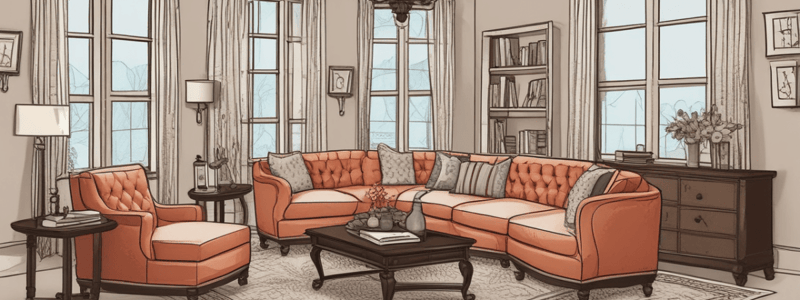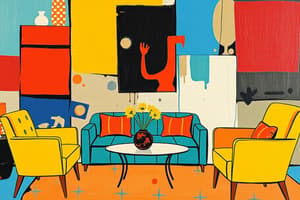Podcast
Questions and Answers
What is a cabriole leg characterized by?
What is a cabriole leg characterized by?
- An elaborate design featuring intricate carvings
- A design that swells outward at the knee and tapers inward at the ankle (correct)
- A straight, angular design tapering at the bottom
- A leg that mimics the shape of a column
What defines a highboy in furniture terminology?
What defines a highboy in furniture terminology?
- A tall chest of drawers with mid-century design (correct)
- A low-profile sofa that can double as a bed
- A piece of furniture commonly used for serving food
- A coffee table with a flat surface and storage space beneath
What type of seating does motion upholstery provide?
What type of seating does motion upholstery provide?
- Static, non-reclining chairs
- Seating primarily designed for formal occasions
- Reclining or inclining seating features (correct)
- Traditional seats without any modern features
Which of these describes a gateleg table?
Which of these describes a gateleg table?
What is the primary function of a sideboard in a dining room?
What is the primary function of a sideboard in a dining room?
Flashcards are hidden until you start studying
Study Notes
Room Elements for Cohesive Design
- Illumination enhances ambiance and highlights features using overhead, task, and accent lighting.
- Window treatments (curtains, blinds, shades) provide privacy and contribute to aesthetics, adding texture and color.
- Textiles (rugs, pillows, throws) introduce comfort and visual interest; mixing textures creates depth.
- Embellishments (artwork, decorative objects, plants) personalize spaces and serve as focal points.
Furniture Basics
- Furniture is categorized into soft goods (upholstered) and hard goods (case goods).
- Selection criteria include style, comfort, durability, and functionality.
- Quality should correspond with price; higher cost does not always guarantee superior quality.
Wooden Furnishings
- The type of timber influences quality; considerations include aesthetics, stability, and finish compatibility.
- Hardwoods (e.g., maple, mahogany) provide strength and stability but are harder to work with.
- Softwoods (e.g., pine, cedar) are malleable for intricate designs but dent more easily.
- Solid wood refers to visible parts made of solid wood, while internal parts may use plywood.
- Plywood offers durability and is commonly used for structural elements like cabinets.
Finishes and Treatments
- Finishes like oil, varnish, and lacquer enhance and protect wooden furniture.
- Stains add color while revealing natural grain; proper application is crucial for consistency.
- Paints offer colorful, opaque finishes; options depend on desired aesthetic.
Construction Techniques
- Furniture longevity hinges on construction quality; key joints include:
- Mortise and Tenon: highlights precise fit and strong adhesion.
- Tongue-in-Groove: ideal for board alignment but not weight-bearing.
- Dovetail: intricately cut for drawers, ensuring strong interlocking.
- Corner Blocks: support weight-bearing joints in systems like chairs.
Upholstered Furniture Components
- Comprises frame, support system, and fabric cover; price correlates with component quality.
- Premium frames use hardwoods; lower-quality frames may warp or lose durability.
- Support systems consist of springs and padding; higher-end use individually tied springs or rubberized webbing.
- Fabrics blend natural/synthetic fibers, treated for durability, comfort, and stain resistance.
Characteristics of Fabrics
- Linen: Durable and breathable, popular for lightweight clothing.
- Wool: Warm and water-resistant, used in winter wear.
- Rayon: Soft with sheen, ideal for formal wear.
- Nylon: Strong and rot-resistant, suited for outdoor gear.
- Acrylic: Cost-effective alternative to wool, used in plush textiles.
- Olefin and Polyester: Durable with practical applications in furniture and clothing.
Furniture Terminology
- Armoire, credenza, and sideboard refer to various storage and display furniture types important for organizing spaces.
- Terms like "KD" (disassembled) and "RTA" (ready-to-assemble) indicate furniture assembly status.
- Understanding terminology aids in identifying and discussing furniture attributes and styles effectively.
Conclusion
- Knowledge of materials, finishes, and construction enhances furniture selection, ensuring both aesthetic appeal and durability.
- Careful consideration of room elements and furniture choices results in spaces that are both personal and functional.
Studying That Suits You
Use AI to generate personalized quizzes and flashcards to suit your learning preferences.




